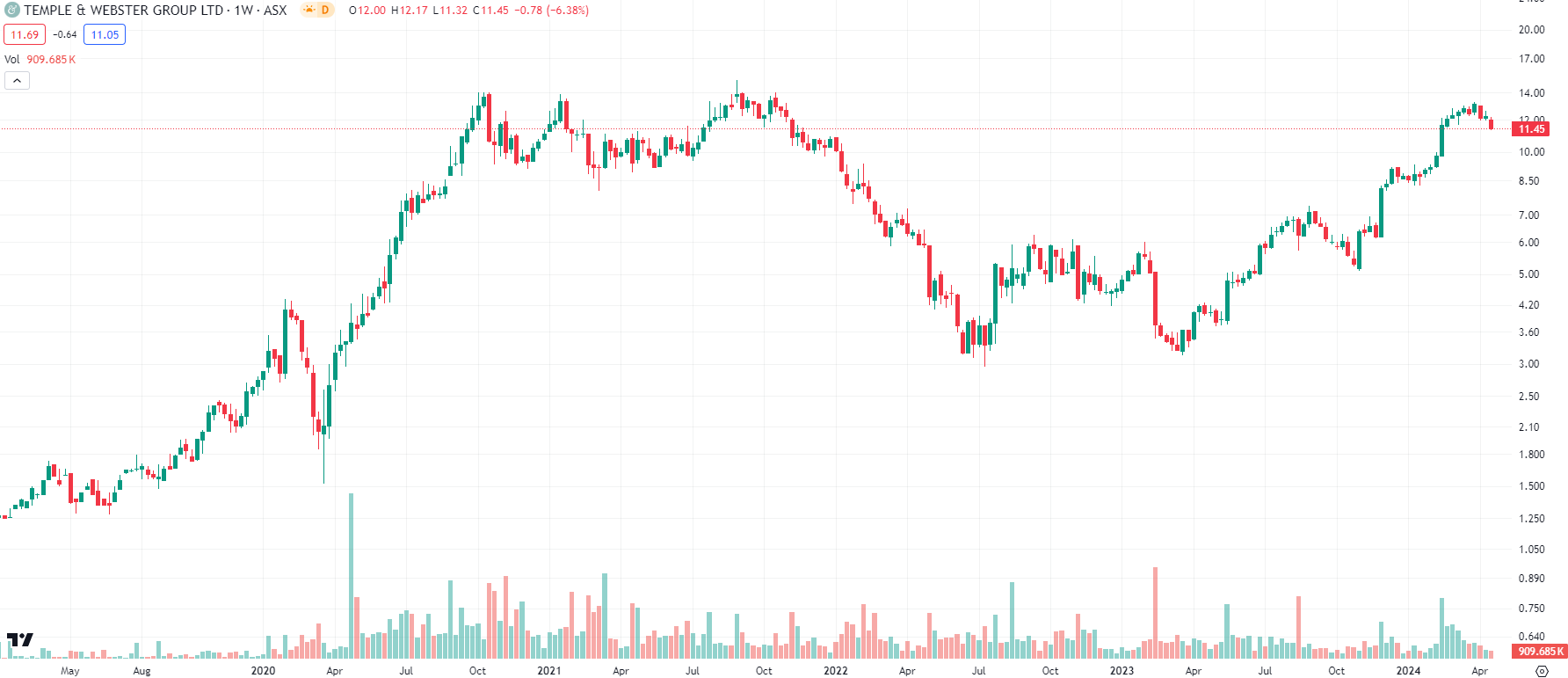Temple and Webster (ASX:TPW): Here’s why there’s still more growth to come from this ecommerce furniture outlet
![]() Nick Sundich, April 22, 2024
Nick Sundich, April 22, 2024
Temple and Webster (ASX:TPW) was one of several homewares and furniture companies to benefit from the pandemic as locked-down consumers spiced up their homes.
Shares retreated as the country re-opened in 2022 and rising interest rates caused high-growth companies to be shunned by investors. But unlike many of its peers, Temple and Webster has undergone substantial growth of late, and is nearly back to its pandemic peak. This is no accident…it is because the company has continued to grow its sales and customer numbers even as the world has re-opened. In fact, its Active Customer Numbers are roughly thrice as high as pre-pandemic. And it has aspirations to become the largest furniture and homewares retailer in Australia and for $1bn+ in annual sales over the next 3-5 years.

Temple & Webster (ASX:TPW) share price chart, log scale (Source: TradingView)
Who is Temple and Webster?
Temple & Webster (ASX:TPW) is an Australian company that operates as an online furniture and homewares destination. Its mission is to ‘make the world more beautiful, one room at a time’. The company began in 2011, and initially operated as a members-only website offering limited-time sales on high-end furniture and home décor. The company eventually opened its doors to all, expanding its product offering both organically and through strategic acquisitions, most notably Milan Direct in 2016 as well as the Australian operations of Wayfair.
When the company listed, which happened in 2015, it had a market capitalisation of $117m, forecasted revenue of $60m for the following 12 months and 190,000 active customers. Today it has a market capitalisation of $1.5bn, nearly $400m in revenue and over 1m active customers!
Growth in personalised furniture
In FY23, the company made nearly $400m in revenue and an $8m profit. It followed this up in 1HY24 with $254m revenue (up 23%) and a $3.9m NPAT (flat compared to 1HY24). It made a 31% contribution margin, impressive in a typically low-margin industry.
What makes it stand apart from its peers? Above all else, its own collection of home furnishings and décor, that aim to reflect customers’ personal style. Among other things are its emphasis on sustainability and ethical production, its AI-powered tools such as The Studio that helps customers visualise how products would look in their own home using augmented reality technology, and its division aimed at professional and trades customers.
Is there really any growth left?
Yes. Investors might be forgiven for thinking there is no growth left in the industry. We acknowledge it may never become a ‘majority eCommerce’ industry, but we still think there is room for growth based on the facts that penetration is higher in other countries, particularly the UK and USA where penetration is nearly 30% as opposed to under 20% here. This is projected to happen as millennials gradually become the largest spending cohort.
Notwithstanding the common stereotypes that they lack the money of previous generations, they are lucrative for a number of reasons. Firstly, this demographic is highly comfortable with online shopping, having grown up during the digital age. Secondly, millennials tend to move more frequently, whether for jobs, seeking new experiences, or adapting to their growing families. This lifestyle makes them more inclined to purchase furniture online that meets their evolving needs and tastes. Thirdly, they are drawn to brands that offer sustainable, stylish, and cost-effective solutions, aligning with their preferences for environmental consciousness and financial savvy. Fourth, they value personalisation and unique experiences that Temple and Webster can offer. And finally, they are entering their prime furniture-buying years.
Big goals!
Temple and Webster aims to grow its revenue to $1bn+ over the next 3-5 years. This would represent high growth, 20-36% CAGR, and is a big claim to make. But if it can achieve this, there would be significant opportunity for shareholder value would be created. It also ought to be born in mind that the company believes it can achieve this even with modest growth in its market share, from 10% to 15%. The company is also aiming to cut its fixed costs as a percentage of sales fro m12% to 6% over the next 5 years.
Even in the shorter-term, the company has guided to shareholders that it can maintain a 30-31% delivered margin and a 3-6% EBITDA margin, in line with FY23 in spite of 4-decade inflation.
Temple and Webster is undervalued compared to its peers
We think TPW at $17.27 per share in a base case scenario using a peer-weighted approach, using its peers on the ASX: Kogan (ASX:KGN), Nick Scali (ASX:NCK), Harvey Norman (ASX:HVN) and Adairs (ASX:ADH) (Figure 9). The quarter has an average market capitalisation of $2.2bn as at April 18 2024.
Temple and Webster trades at a significant discount compared to them. A $2.2bn market cap implies a share price of $17.27. We have also forecasted a bull case, where we apply a 25% premium to Temple and Webster and derive $21.59 per share.
The key risks to this thesis include macroeconomic risks, competition risks, key personnel risk and cyber risk.
Conclusion
There are plenty of reasons to look at Temple and Webster. It has:
- A customer base that is sticky, growing, high-margin and constantly coming back,
- An income statement in positive territory profitable
- Already been deriving benefits from AI
- Proven itself resilient to adverse economic conditions
- Exposure to a market that remains nascent and is set to grow in the years ahead.
This stock is one to keep your eye on.
What are the Best ASX Stocks to invest in right now?
Check our buy/sell tips
Blog Categories
Get Our Top 5 ASX Stocks for FY25
Recent Posts
Your invitation to the Freelancer Investor Day
Your invitation to the Freelancer Investor Day Freelancer (ASX: FLN) is a Sydney-based company that has been the subject of…
Kamala Harris stocks: If Joe Biden’s VP wins the White House in 2024, which stocks will win?
With the US Presidential election now certain to be a Kamala Harris v Donald Trump showdown, we’ve looked at so-called…
South32 (ASX:S32): Is it the dark horse amongst ASX 200 miners or have cyclones and commodity prices hit it too hard?
South32 (ASX:S32) began life as a spinoff from BHP back in 2015, capitalised at $9bn. In mid-2024, it is capped…



